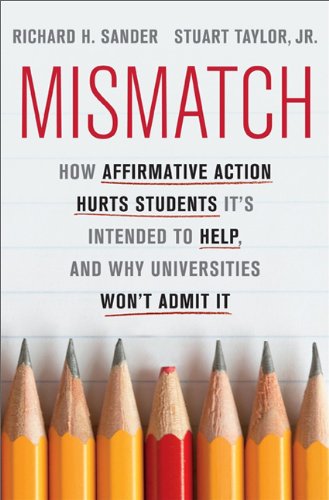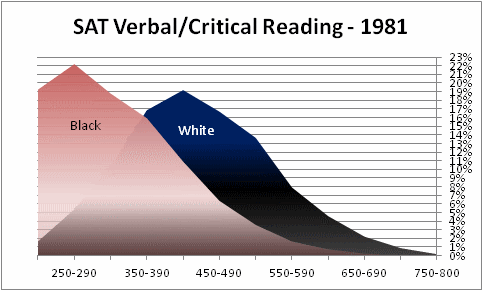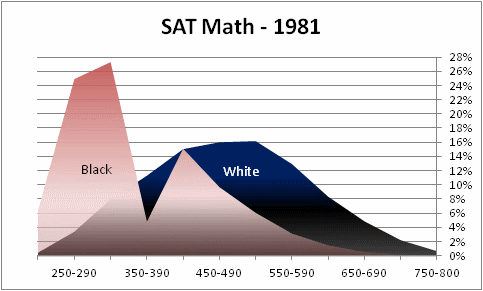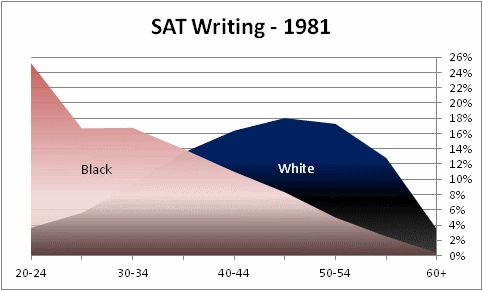 The Painful Truth About Affirmative Action describes how mismatched students are admitted to colleges where they don’t belong nor thrive, where they suffer and tend to drop out.
The Painful Truth About Affirmative Action describes how mismatched students are admitted to colleges where they don’t belong nor thrive, where they suffer and tend to drop out.
They are academic failures and rank at the bottom of their classes. This reinforces the stereotypes of academically inept Blacks and Hispanics, damages the self-esteem of failing minority students that would thrive in less selective colleges. It also is damaging to competent Black and Hispanic students who do not need quotas but who get confused with low performing quota students.
UCLA went through various phases of affirmative action and minority admissions. It is taboo to mention the unspoken secret: when UCL admitted twice as many minorities, drop-out rates increased drastically and in the end the number of minority graduates remained equal. Admitting too many vastly under qualified minorities yields no positive results. It only wastes money and traumatizes students.
Colleges actively hide the truth about the failure of affirmative action.
It is also always overlooked, that discriminated disadvantaged Asians over-perform. Even the mismatch article is shy to admit that this is due to Asian’s genetically superior IQ, augmented further by a culture that values academic success).
The issues of the above summary will be shown in detail in the quotes below
Mismatch: How Affirmative Action Hurts Students It’s Intended to Help, and Why Universities Won’t Admit It (Book)
The Painful Truth About Affirmative Action
The single biggest problem in this system — a problem documented by a vast and growing array of research — is the tendency of large preferences to boomerang and harm their intended beneficiaries. Large preferences often place students in environments where they can neither learn nor compete effectively — even though these same students would thrive had they gone to less competitive but still quite good schools.
We refer to this problem as "mismatch," a word that largely explains why, even though blacks are more likely to enter college than are whites with similar backgrounds, they will usually get much lower grades, rank toward the bottom of the class, and far more often drop out. Because of mismatch, racial preference policies often stigmatize minorities, reinforce pernicious stereotypes, and undermine the self-confidence of beneficiaries, rather than creating the diverse racial utopias so often advertised in college campus brochures.
The mismatch effect happens when a school extends to a student such a large admissions preference —
Of course, being surrounded by very able peers can confer benefits, too — the atmosphere may be more intellectually challenging, and one may learn a lot from observing others. We have no reason to think that small preferences are not, on net, beneficial. But contemporary racial preferences used by selective schools — especially those extended to blacks and Native Americans — tend to be extremely large, often amounting to the equivalent of hundreds of SAT points.
We have no reason to think that small preferences are beneficial, either.
To be fair, I personally talked to an astronomer. He knows people with high intelligence but from bad secondary schools, who were admitted on quotas. The quotas were not racial quotas but public-school-student quotas. These students started with bad grades and then remedied their lack of schooling. After a few months they were very able and competent students.
The problem with racial quotas is that they are based on the fallacy that there are no racial difference in iq.
But in fact it is a largely invisible issue. With striking uniformity, university leaders view discussion of the mismatch problem as a threat to affirmative action and to racial peace on campuses, and therefore a subject to be avoided. They suppress data and even often ostracize faculty who attempt to point out the seriousness of mismatch. (See, for instance, the case of UT professor Lino Graglia, who was condemned by university officials after he observed that black and Mexican-American students were "not academically competitive" with their white peers.) We believe that the willful denial of the mismatch issue is as big a problem as mismatch itself.[…]
The way racial preferences affect student outcomes is only part of the story. Equally relevant is the way the academic community has proved unequal to the task of reform — showing great resourcefulness in blocking access to information, enforcing homogenous preference policies across institutions, and evading even legal restrictions on the use of preferences. All of this makes the quest for workable reforms — which are most likely to come from the Supreme Court — both more complex and more interesting than one might at first suspect.
UT professor Lino Graglia actually was extremely careful to only blame culture and not racial differences in iq.
Mr. Graglia, who is of Italian descent, has staunchly defended his recent comments, insisting in an interview that he did not believe minority students were intellectually or genetically inferior. Instead, he said, he was trying to find the ”least controversial, the most congenial response” to the question of why they did not do as well as white students in a race-blind admissions process.
”So I said there is a cultural factor at work,” he said in a telephone interview. ”It appears to be the case that somehow, some races see to it that their kids are more serious about school. They cut less and they study more.” UT professor Lino Graglia
 Back to The Painful Truth About Affirmative Action:
Back to The Painful Truth About Affirmative Action:
the university reinstituted covert, illegal racial preferences.
Throughout these crises, university administrators constantly fed agitation against the preference ban by emphasizing the drop in undergraduate minority admissions. Never did the university point out one overwhelming fact: The total number of black and Hispanic students receiving bachelor’s degrees were the same for the five classes after Prop 209 as for the five classes before.
How was this possible? First, the ban on preferences produced better-matched students at UCLA, students who were more likely to graduate. The black four-year graduation rate at UCLA doubled from the early 1990s to the years after Prop 209.
Second, strong black and Hispanic students accepted UCLA offers of admission at much higher rates after the preferences ban went into effect; their choices seem to suggest that they were eager to attend a school where the stigma of a preference could not be attached to them. This mitigated the drop in enrollment.
Third, many minority students who would have been admitted to UCLA with weak qualifications before Prop 209 were admitted to less elite schools instead; those who proved their academic mettle were able to transfer up to UCLA and graduate there.
Thus, Prop 209 changed the minority experience at UCLA from one of frequent failure to much more consistent success. The school granted as many bachelor degrees to minority students as it did before Prop 209 while admitting many fewer and thus dramatically reducing failure and drop-out rates. It was able, in other words, to greatly reduce mismatch.
But university officials were unable or unwilling to advertise this fact. They regularly issued statements suggesting that Prop 209’s consequences had caused unalloyed harm to minorities, and they suppressed data on actual student performance. The university never confronted the mismatch problem, and rather than engage in a candid discussion of the true costs and benefits of a ban on preferences, it engineered secret policies to violate Prop 209’s requirement that admissions be colorblind.
The odd dynamics behind UCLA’s official behavior exist throughout the contemporary academic world. The quest for racial sensitivity has created environments in which it is not only difficult but downright risky for students and professors, not to mention administrators, to talk about what affirmative action has become and about the nature and effects of large admissions preferences.
Race and IQ Taboo
 Even these researchers try to find cultural explanations and deny racial differences. They skirt one taboo: they see the hidden truth, the failure of affirmative action. Most do not break the second taboo, to see the intrinsic genetic differences between races.
Even these researchers try to find cultural explanations and deny racial differences. They skirt one taboo: they see the hidden truth, the failure of affirmative action. Most do not break the second taboo, to see the intrinsic genetic differences between races.
The fact that a test that accepts the top 5% of Whites, will accept about 10 % of Asians and 1% of Blacks when measured by the same criteria. (sorry, these numbers are estimates. Anyone can read the SAT and IQ statistics and calculate the correct numbers based on those statistics?)
Political correctness‘s faulty assumptions about race and iq, and about equality of genders lead to false policies and damaging effects. The race and iq issue have been dealt with extensively at human-stupidity.com. Cultural issues of Black culture not promoting academic success and diligent study are an additional issue, not the only reason for different academic success for Blacks and Hispanics.
The SAT test is basically an iq test. One simply can not find many Blacks past 700. A school with a cutoff of 750 in Math will simply be hard pressed to find Blacks in any significant amounts.
I think affirmative action should be for U.S. citizens and permanent residents first. Foreign nationals should not be given affirmative action over Americans because of race. Too many foreign nationals are taking opportunities from Americans.
The question, of course, is always “Who benefits?” Sure, the more marginal NAM students who end up failing out of college and having college loan debt are probably hurt, but upper-class blacks and Hispanics usually scrape by, and make out like bandits from AA, both official and unofficial. I doubt that Barack Obama (who probably got a modest boost from AA, and a big boost from societal negrophilia that enables AA) or his wife (who would never have gotten anywhere without AA), would want it done away with. And it’s folks like these that are the political representatives of blacks and Hispanics, who stick by their leaders out of ethnic solidarity.
Appealing to logic, justice, or societal costs and benefits, is therefore useless. As long as blacks and Hispanics stand behind them, and whites do nothing, the NAM political class will continue its depredations.
Stand up to the PC police: http://www.youtube.com/watch?v=H4zSRkBMPng
Personally I couldn’t care less about the self-esteem of those black/Hispanic students admitted because of their race. The real victims are whites. It is whites who are denied access, due to their race, who I sympathize with.
@jewamongyou, I understand your standpoint. One can argue the injustice of denying Whites (or Asians) a place at a University in order to favor a totally outclassed Black or Hispanic with radically lower SAT scores. Especially if one understands that the test scores will not change, that they are due to different lower IQ, that this person will NOT radically improve once in the Elite University.
But the interesting point is that even the minority student is damaged. It is like giving you a chance to fight Mike Tyson. You will just be embarrassed and damaged. So being outclassed in a University and at the bottom 10% of the grading curve is just embarrassing and waste of time. That student is very unlikely to graduate.
And it even is damaging to the capable minority student who fulfills the admission requirement. He will be suspected to be a quota student, his true skills will not be believed.
It is a lose-lose situation.
Yes, it’s a lose-lose conundrum, because, to quote someone, “no group will accept their intellectual inferiority”, and you, the author of a blog about human stupidity, won’t deny this reality.
So, we can’t make people perform at the same level, and we can’t say, or allow it to be very visible, that they don’t perform at the same level.
How is it solved?
You’d need great sense of responsibility on the part of nearly all media people, and public figures overall. The differences would become very little thought-about if these people didn’t keep pointing out and decrying them on a regular basis. But they do — because it gives them professional and othe status gains.
It becomes a lose-lose-lose conundrum.
Which ethnic states would solve, and currently do solve in every socially cohesive country.
All countries that work well are more or less ethnic states. And the USA could be split into different areas for different people.